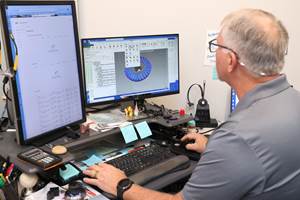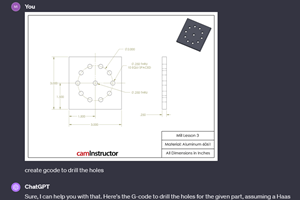Company Provides Fast Turnaround For Molds For Sunglasses
Bausch and Lomb, the optics manufacturer, needed aluminum rapid prototype molds for the introduction of its Inertia Combo Ray-Ban sunglasses line. The schedule allowed for less than four weeks from completion of the geometry to the first molded plastic parts. The company turned to the two-year-old ROMOLD, Inc. for quick turnaround of the plastic injection molds from Bausch and Lomb's Unigraphics design files.
Share





Bausch and Lomb, the optics manufacturer, needed aluminum rapid prototype molds for the introduction of its Inertia Combo Ray-Ban sunglasses line. The schedule allowed for less than four weeks from completion of the geometry to the first molded plastic parts. The company turned to the two-year-old ROMOLD, Inc. (Rochester, New York) for quick turnaround of the plastic injection molds from Bausch and Lomb's Unigraphics design files.
"Bausch and Lomb wanted us to manufacture the aluminum molds ASAP to produce samples for their marketing program while we were building their production molds," says ROMOLD's vice president, Craig Lockwood.
Because the customer needed three plastic parts for the sunglasses fast, it was more cost-effective to order one three-cavity family mold: left and right temple, or ear piece sections of the sunglasses, and one front section which holds the lenses. Bausch and Lomb sent the CAD data and "We read the Unigraphics IGES files directly into Mastercam (Tolland, Connecticut)," Mr. Lockwood notes. "We want to be able to get a file and go—otherwise we waste time worrying about incompatibilities and data loss."
Once the staff members at ROMOLD looked over the Unigraphics files, they ran into a common problem. While the files were aesthetically pleasing, they were not ready for machining. "We had to perform some major surgery on the parts to get them ready for the shop," Mr. Lockwood recalls. For instance, some surfaces were actually folded over others. "We had to edit the geometry so that the surfaces would be continuous relative to the direction of draw as the mold opens and as the plastic is ejected," Mr. Lockwood explains. "We had to remove parts of those surfaces and patch with new ruled surfaces. Once we cut the old surface out and trimmed it to the construction lines, we were able to create the new surfaces with ease. We use Mastercam for our CAD as well as our CAM needs, so we were able, with Bausch and Lomb's concurrence, to edit the models immediately and keep the entire prototyping process up to speed.
"We added shrinkage into the parts files, offsetting the geometry accordingly," he adds. "We created a parting line, split the cores from the cavities and extended the surfaces to the end of the mold." Because of the deep curve and contoured nature of the Ray-Ban line of glasses frames, the parting lines on both the fronts and temples corresponded closely to the contour of the pieces. So creating the parting line became a complex 3D operation. Mold Plus, an add-on to Mastercam, quickly created the complex parting line and separated the mold's core and cavity accurately in minutes.
On this prototype, the ROMOLD team had to hand load inserts into the mold halves for undercut areas rather than using slides. "These were especially difficult to design—to think in 3D around a 3D parting line," Mr. Lockwood recalls. "We'd brainstorm; form one theory after another; go through them in a scientific approach. But when we couldn't prove a method theoretically, we'd create it in Mastercam and either verify our solution or re-engineer and model again.
"Next, other mold components like ejector pins, runners, gates, leader pins were added to the surface files. We've created CAD geometry for most of our common mold components. We bring them into the surface file on separate levels or in different colors."
Drilling and milling operations begin the machining process. The CNC programmer created toolpaths using a variety of programming options and cutting tools to make ejector pin holes, runners, and other features. Up to 80 percent of the standard mold features were machined in one setup with a toolchanger and one program.
"We used a parallel multisurface roughing technique at a high feed to remove material from the parting line and cavity quickly," Mr. Lockwood says. Then he used another parallel multisurface finish toolpath for the finish. Average finish stepover passes were about 0.001 inch to 0.002 inch at a feed rate of 30 to 70 ipm.
"While our CAM software has an extensive tool library, we can also customize tool specifications, add the templates to the tool library and have them to use instantly whenever that application is called for," Mr. Lockwood notes.
The prototype mold was machined from two 5 inch by 12 inch by 14 inch pieces of QC7 aluminum. "Once we determined exactly what we wanted," Mr. Lockwood adds, "the roughing toolpath ran flawlessly and the finish passes left virtually perfect mold surfaces—so good, in fact, that Bausch and Lomb actually began running production parts from our aluminum prototype molds before we delivered the finished steel production molds."
Related Content
Large-Format Machining With Small Cutting Tools and Dynamic Motion
Napoleon Machine, a defense contractor that provides parts for the M1 Abrams tank, recently took advantage of a CAM feature that allowed the company to streamline its cutting strategies and program offline. Here’s how the shop cut cycle times nearly in half with its large-format five-axis machining operations.
Read MoreTTI Brings Specialty Gear Production In-House with Multiaxis Machining
By investing in a 3+2-axis machine and utilizing simulation software for diagnostic checks, Techtronic Industries turned a four- to ten-week lead time into a one- to two-week lead time.
Read MoreCan ChatGPT Create Usable G-Code Programs?
Since its debut in late 2022, ChatGPT has been used in many situations, from writing stories to writing code, including G-code. But is it useful to shops? We asked a CAM expert for his thoughts.
Read MoreFive-Axis CAM Strategies Cut Cycle Time for Two Shops
After being acquired by the same parent company, two shops found that working together and sharing knowledge improved both of their bottom lines.
Read MoreRead Next
AMRs Are Moving Into Manufacturing: 4 Considerations for Implementation
AMRs can provide a flexible, easy-to-use automation platform so long as manufacturers choose a suitable task and prepare their facilities.
Read MoreMachine Shop MBA
Making Chips and Modern Machine Shop are teaming up for a new podcast series called Machine Shop MBA—designed to help manufacturers measure their success against the industry’s best. Through the lens of the Top Shops benchmarking program, the series explores the KPIs that set high-performing shops apart, from machine utilization and first-pass yield to employee engagement and revenue per employee.
Read More





















